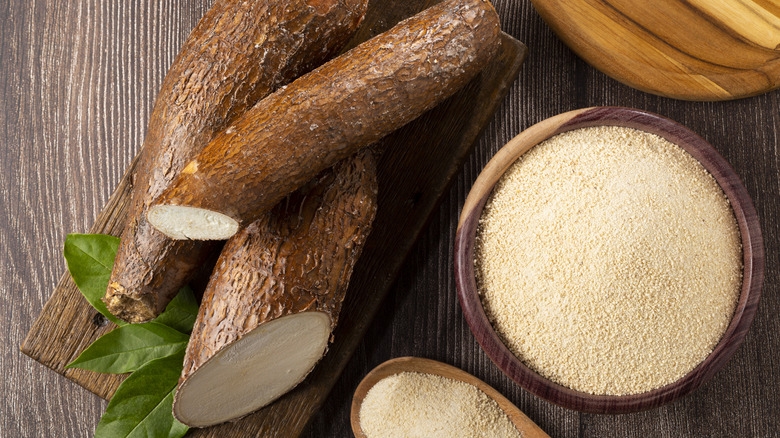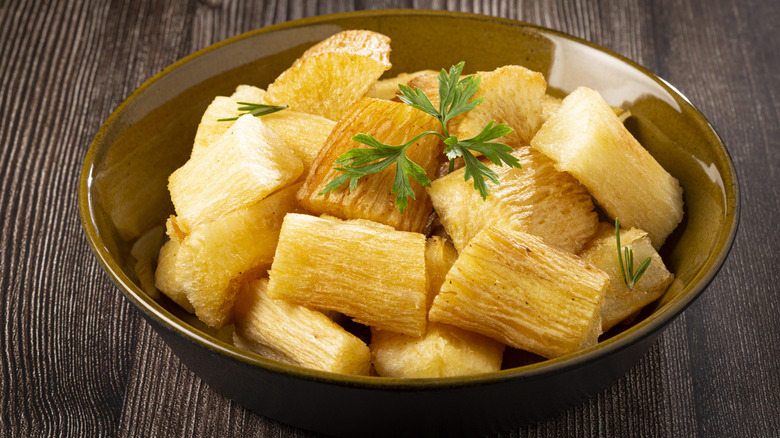Cassava: The Versatile Root Vegetable That Is More Dangerous Than It Looks
Have you ever eaten banana tapioca pudding, sago, or other desserts made with tapioca pearls? This versatile ingredient comes from cassava root, a crop that grows in South America, Africa, and the Caribbean. After rice and corn, cassava is the third most important food in the tropics and a diet staple for about 800 million people worldwide, according to a 2010 review published in the journal Sustainability. But what many Westerners don't know is that this starchy tuber can be poisonous in its raw form.
Also known as yuca or manioc, cassava looks similar to yams or sweet potatoes and has a multitude of uses. Its leaves and roots play a key role in the production of alcohol, sweeteners, human food, textiles, biofuel, and laundry starch. The root is nutrient-dense, offering 330 calories, 2.8 grams of protein, and 78 grams of carbs, including 3.7 grams of fiber, per cup. It also boasts nearly half of the recommended daily vitamin C intake and large amounts of potassium, copper, magnesium, folate, and B vitamins.
Due to its high nutritional value, cassava root may help improve immune function, reduce inflammation, and protect against chronic disease. Resistant starch, one of its main components, increases satiety and promotes gut health. But despite these potential benefits, cassava can cause severe toxicity or even death.
Why you should never eat raw cassava
Back in 2017, 98 Ugandans were admitted to the hospital with vomiting, diarrhea, fever, convulsions, and rapid breathing. Two lost their lives after eating cassava flour with a high cyanide content, according to a report from the CDC. This toxic compound occurs naturally in raw cassava, but it's normally removed during processing. Its role is to protect the plant from mites, whiteflies, and other pests. However, it can be lethal when consumed by humans, according to the journal Sustainability.
More than 2,000 plants, such as apples, cherries, mangoes, and peaches, contain cyanide, but this compound is found in their seeds or other inedible parts. Cassava, on the other hand, produces cyanide in its leaves and roots. Linamarin and lotaustralin, the main cyanogenic glycosides in this crop, may cause fatigue, stomach upset, headaches, and other mild symptoms within hours of consumption. Higher doses can lead to partial paralysis of the legs, chronic neurological disorders, or even death. Other symptoms of cyanide poisoning may include endocrine dysfunction, heart palpitations, confusion, and low blood pressure, according to Hong Kong's Center for Food Safety (CFS).
Bitter cassava is much lower in cyanide than sweet cassava roots. However, both varieties can cause acute or chronic toxicity and must be cooked thoroughly before consumption. The CFS also recommends buying cassava from trusted suppliers and eating it as part of a varied diet. Generally, the cassava sold in the U.S. undergoes extensive processing, which decreases its cyanide content.
How to prepare and cook cassava root safely
According to the CFS, sweet cassava roots should be peeled and cooked before eating. If you have a piece of bitter cassava, you should also grate it and soak it in water prior to cooking. Another option is to peel the root, cut it into small pieces, soak them in water for four to six days, and then cook them. These processing methods will affect its nutritional value but also make it safe for consumption. Simply removing the peel can reduce its cyanide content by half. Soaking the roots in water will remove another 20% of their cyanide content.
Raw cassava is one of the most dangerous foods on earth, but it becomes safe after processing. Once you've soaked it in water, you can boil, fry, or roast it, just as you'd do with potatoes. For example, fried cassava tastes similar to sweet potato fries and can be served with mayo or garlic sauce. If you have a sweet tooth, mix grated cassava with sugar and coconut milk to make Suman, a Filipino dessert. Scoop the paste into banana leaves, roll them tightly, and then steam them until tender.
Cassava root can also be a delicious addition to pulled pork, cheese balls, soups, stews, pies, and even cakes. In general, boiled or steamed cassava roots are slightly sweet, while roasted cassava has a caramelized flavor. This starchy root also absorbs other flavors, making it suitable for both savory and sweet dishes.


